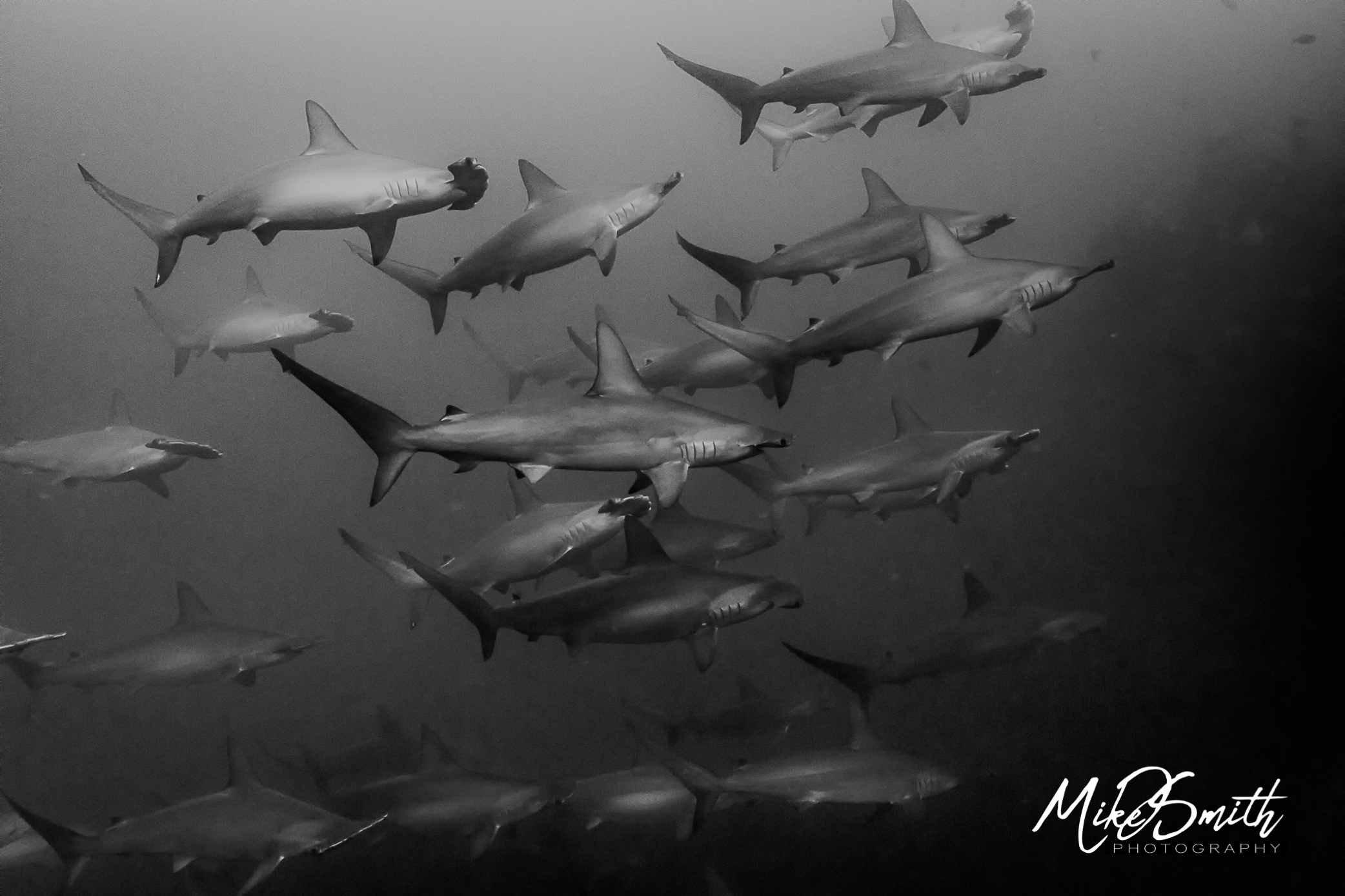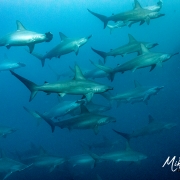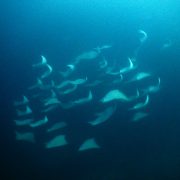The wonders of the unknown
by Steph Venables, Marine Megafauna Foundation
Science is all about answering questions.
One of the things I love most about it, is that there are still so many things that we don’t know, and so many questions to be answered…
It’s no secret that schooling hammerheads were the number one goal of the recent Off the Chart Expedition to the Banda Sea. Our dive schedule was tailored specifically to fit in as much hammertime as possible and over the course of the week. We spent hours (literally) gazing out into the blue, waiting for a glimpse of those weird and wonderful creatures as they swam past.
Whether it was a single shark, or a group of over a hundred, the encounters were impressive and mesmerizing. The schools seemed to go on forever as they swam past, more sharks than you could count, and those were just the ones we could see!
Hammerheads belong to the family Sphyrnidae. Only 2 of the 9 species of hammerhead (yep, that’s right, there are 9 different species) are known to aggregate in large schools. Sometimes in groups of hundreds.
These are smooth (Sphyrna zygaena) and scalloped hammerheads (S. lewini). Schools typically form during the day around seamounts and remote oceanic islands and the sharks disperse at night to hunt – hammerheads typically feed on fish, squid, octopus, crustaceans and sometimes even stingrays and smaller sharks.
The more well-known locations to witness these spectacular schools include Wolf and Darwin islands in the Galapagos, Espiritu Santo (Sea of Cortez), Cocos and Malpelo islands (Eastern Tropical Pacific), Layang Layang (Malaysia) and more recently in Indonesia’s Banda Sea.
The question is why do they school?
The answer… we don’t really know.
Schooling is typically seasonal in most locations and we aren’t exactly sure where the sharks go when they leave these aggregation sites. There are a number of theories as to why hammerheads school. These include hunting, mating, socializing and protection.
Some schools are primarily made up of females, ranging in size and maturity from larger adults to smaller adolescents. There appears to be a dominance hierarchy among the group. The largest, fittest females in the middle of the school and the smaller females surrounding them on the outskirts. Males will typically swim into the middle of the school when looking for a mate. This ensures the males are mating with the biggest and more reproductively fit females.
Another theory
Known as “refuging”, where these areas serve as social meeting places conveniently located close to areas of high food availability. The seamounts or islands may be used as an undersea landmark. Where sharks can interact socially during the day. Then they disperse after sunset to find dinner.
Schooling Hammerheads
Scalloped hammerheads have just had their conservation status updated from Endangered to Critically Endangered on the IUCN red list of threatened species , and understanding their behavior and movement patterns is important in being able to provide them with effective protection measures in the future.
Some things we do know…
Hammerheads are one of the most recognizable shark species, thanks to the unusual shape of their head. This is known as a ‘cephalofoil’ and has a number of benefits from providing greater lift and increased stability when turning to enhancing senses and even pinning down prey.
Hammerheads, like humans, have binocular vision and their eyes are positioned on either side of the head. Having wider set eyes increases the extent of the sharks visual range, and improves depth perception, therefore improving their vision. On top of this, hammerheads possess electroreception (like all sharks) and use hundreds to thousands of small pores in their skin called ‘Ampullae of Lorenzini’ to detect the electromagnetic fields that are emitted by all living things. They use this sense to detect prey. For hammerheads the cephalofoil provides a wider surface area for these pores, which are also more concentrated on the lower surface than they would be for other sharks, enabling them to use their heads to find prey as we would use a metal detector to find buried treasure (or car keys).
 3D image of a hammerhead produced using X-ray scanning techniques
3D image of a hammerhead produced using X-ray scanning techniques
An added bonus
Great hammerheads (which can grow to 6 m long) have been witnessed using their broad head to pin stingrays to the ocean floor.
So they can eat them. Sweet party trick!
Some of my other favourite hammerhead facts include:
- Hammerheads can suntan! The more time they spend in shallow, clear waters, the darker their skin seems to get.
- Great hammerheads (S. mokarran) are sideways swimmers. They have extremely large dorsal fins, which are actually longer than their pectoral fins. This means swimming on their side reduces drag and is the most energy efficient way to swim.
- A phenomenon called ‘parthenogenesis’ has occurred in bonnethead sharks (S. tiburo). A female kept in captivity became pregnant without contact with a single male shark. DNA tests showed no paternal DNA, which means she fertilized her own eggs… Virgin birth!
- Bonnethead sharks also known to eat seagrass. Nom.
… but back to things we don’t know
While hammertime was at the top of the ‘to do’ list. A close second was to see if we were lucky enough to see a manta ray. Giant (or oceanic) manta rays (Mobula birostris) are sighted throughout Indonesia with known aggregation sites in Raja Ampat and Solor.
Occasionally sightings are reported in Fak Fak (mainland West Papua), Komodo National Park and the Nusa Tenggara islands.
 Face to face with a giant manta ray, M. birostris
Face to face with a giant manta ray, M. birostris
We have also had infrequent reports of giant manta rays in the Banda Sea. Some were stories from fellow divers and photographers and we also had a couple of uploads to the citizen science platform MantaMatcher.org. Divers can submit manta ray ID photos to contribute to global science and conservation programs across the globe (check it out here). Like a human fingerprint, the spot pattern on a mantas belly is unique. It can be used to identify individuals. This is an easy and effective method of learning about manta ray populations and is used all around the world. From the infrequent nature of sightings in the Banda Sea, it could be that the manta rays are just passing through this region.
So, where are they coming from/going?
Well, again, we don’t know.
The most likely theory is that they are travelling South from Raja Ampat, crossing the Ceram Sea. Navigating around Maluku and into the Banda Sea. Giant manta sightings are seasonal in the Dampier Strait region of Raja Ampat, with numbers peaking from December to April each year.
Slighty further south in Misool, sightings are year-round, but they peak from Feb-May. Photo-ID data has shown that giant mantas move between Dampier and Misool and mantas fitted with satellite tags in Misool moved south into the Ceram Sea, towards Banda. (more info here). Giant manta rays can travel distances of over 1000 km, so they are certainly capable of making the journey from Misool (approx. 400km) or the Dampier Strait (approx. 600km away).
One way we would be able to determine whether mantas are moving between these regions is to match an ID photo of a manta seen in Banda with one seen in Raja Ampat, and I had my fingers and toes crossed for us to see a manta on this trip.
Our Lucky Moment
The lucky moment occurred at Gili Manuk, a remote volcanic island famous for sea snakes and hammerheads. Jackie, the owner of Panunee and Nofrey the boat’s cruise director were the lucky divers. Encountering an inquisitive giant manta at 30m!
Most importantly (for the science, of course) Jackie was able to get a video! None of the dive guides had ever seen a manta ray at Gili Manuk before, which goes to show it’s all about being in the right place at the right time.
Video : credit Aoy Kittisarn, Panunee Yacht
Video of the giant manta sighted at Gili Manuk
I rushed to check the mantas spot pattern against our database while still on the boat, but alas, no match! I also sent out the ID to colleagues who monitor the manta population in Misool and no match there either. We will keep the ID in the database and who knows where and when this manta will show up again.
Thanks to Off the Chart expeditions, scientists like myself are able to get out to remote regions, and begin to answer questions that will take us one step closer to better understanding and better protecting threatened marine megafauna species.
How to get involved?
Keep your eyes peeled for upcoming trips, come and join us to keep blowing the socks off science. Who knows what we will find next time?!
Check out the Marine Megafauna Foundation and their ongoing research and conservation work here, and follow them on Facebook here and here



















